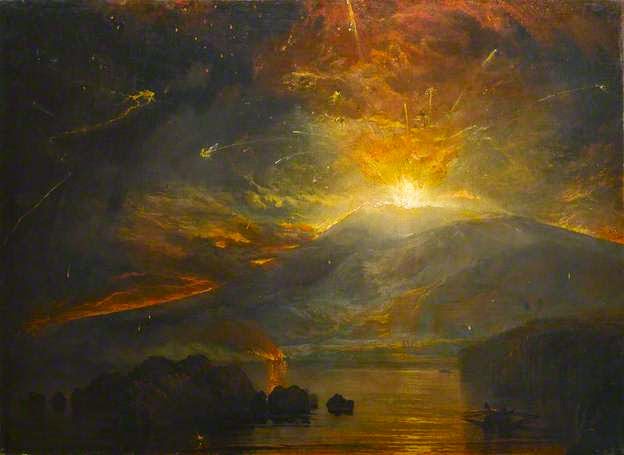'Why, you ask, are there such terrible things as volcanos? Of what use can they be?'
The Eruption of the Souffrier Mountains, in the Island of St Vincent, at Midnight, on the 30th of April, 1812, from a Sketch Taken at the Time by Hugh P. Keane, Esqre by Joseph Mallord William Turner
Pg 71 - The flow of a lava stream. This BBC site has some spectacular photos of lava flows.
Pg 72-73 - Trees ( I've put some pictures of these plus additional pictures & videos of other subjects on my Ambleside Online board at Pinterest).
Pg 73-74 - Kingsley tells about the threat by the eruption of Mt Etna on the town of Catania in Sicily. The story of Catania is also told by Fabre in The Story Book of Science. Fabre has a kinder attitude to the inhabitants of the town in his rendering of the story.
Pg 74 - Lava entering the sea Hawaii (or Sandwich Islands as they used to be known).
Pg 73-74 - Kingsley tells about the threat by the eruption of Mt Etna on the town of Catania in Sicily. The story of Catania is also told by Fabre in The Story Book of Science. Fabre has a kinder attitude to the inhabitants of the town in his rendering of the story.
Pg 74 - Lava entering the sea Hawaii (or Sandwich Islands as they used to be known).
There are some spectacular photos of lava from a vent in Hawaii's Kilauea volcano as it reaches the sea on this National Geographic website.
And now you will ask me, with more astonishment than ever, what possible use can there be in these destroying streams of fire? And certainly, if you had ever seen a lava stream even when cool, and looked down, as I have done, at the great river of rough black blocks streaming away far and wide over the land, you would think it the most hideous and the most useless thing you ever saw. And yet, my dear child, there is One who told men to judge not according to the appearance, but to judge righteous judgment. He said that about matters spiritual and human: but it is quite as true about matters natural, which also are His work, and all obey His will.
Pg 75 - The richness of volcanic soils. This short article answers the question of 'Why do people live on volcanoes?' 'Volcanic ash can be considered as a time-release capsule, rich in nutrients.'
Of course, when the lava first cools on the surface of the ground it is hard enough, and therefore barren enough. But Madam How sets to work upon it at once, with that delicate little water-spade of hers, which we call rain, and with that alone, century after century, and age after age, she digs the lava stream down, atom by atom, and silts it over the country round in rich manure. So that if Madam How has been a rough and hasty workwoman in pumping her treasures up out of her mine with her great steam-pumps, she shows herself delicate and tender and kindly enough in giving them away afterwards.
Pg 78 - The 1812 eruption of St Vincent in the West Indies was witnessed by plantation owner and barrister, Hugh Perry Keane. He recorded his observations in a diary and also made a sketch which was what Turner based his painting above upon.
 |
| The Commonwealth |
Pg 80 - Madame How's remaking of the land. The book below would be interesting for a child who's not an independent reader. It's recommended for Grades 2 to 4 and is based on the eruption of the Paricutin volcano (the volcano in a cornfield) in Mexico in 1943. I borrowed this book from the library years ago and it was a hit with the boys.
Pg 77 - Kingsley mentions atoms in a few places and I found this video which gives a simple and clear explanation on atoms, molecules and bonding.
What's all the matter? Atoms and Molecules: Atoms, elements and molecules. Understanding the building blocks of matter.
Pg 84 - there's a brief mention of millions of years
The Gallery of Natural Phenomena has some topics of general interest relating to what is covered in MHLW.
What's all the matter? Atoms and Molecules: Atoms, elements and molecules. Understanding the building blocks of matter.
Pg 84 - there's a brief mention of millions of years
The Gallery of Natural Phenomena has some topics of general interest relating to what is covered in MHLW.



No comments:
Post a Comment